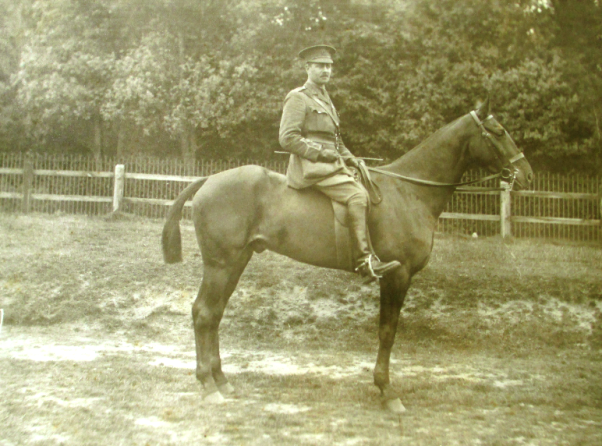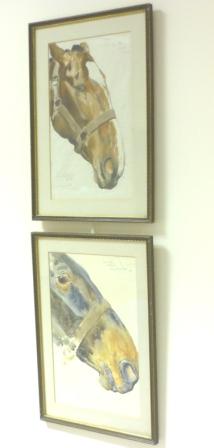The Lightbox in Woking, is currently showing an exhibition describing the role of horse and mules in World War 1. The Horse at War: 1914-18 has a wide ranging display of artwork both from the war itself as well as more recent works, most noticeably ‘Joey’ the life size puppet from the National Theatre’s stage production of War Horse. Amongst the many paintings on display are works by a number of official war artists including Sir Alfred Munnings, CRW Nevinson and Lucy Kemp Welch.
There are a number of interesting veterinary connections amongst the paintings. We have loaned two paintings by Lionel Edwards . Born in Bristol in 1878, Edwards was one of the most popular illustrators of hunting and sporting subjects of the twentieth century. His artistic talents were apparent early in life, drawing horses from the age of six. He studied in London at Heatherly’s School of Art, before pursuing a professional career as an artist. At the outbreak of war he enlisted and served as a Remount Purchasing Officer, responsible for purchasing horses, an experience he described as ’four solid years of nothing but horse.’
Also on display are a number of works by official war artist Edwin Noble. Noble studied at the Slade School of Art and the Royal Academy and became an established illustrator prior to the war. He served with the Army Veterinary Corps, rising to the rank of sergeant, spending much of the war at No 8 Veterinary Hospital in France. Here he recorded in great detail the diseases affecting horses, ranging from mange through to the effects of mustard gas. His pictures were described as providing an ‘almost veterinary eye view of the misfortunes of horses on active service.’

A Horse Ambulance Pulling a Sick Horse out of a Field by Edwin Noble © IWM (Art.IWM ART 2922)
There are three works of art on display produced by a veterinary surgeon, but one who was serving with the Royal Army Medical Corps during the conflict.
Herbert Lake was born in 1883, at 33 High Street Camden, London, where his father owned a jewellers shop. Qualifying from the Royal Veterinary College in 1905, he initially worked in London passing the examinations for an Inspector of Meat and other Foods, in December 1908. Soon after he entered University College London to read medicine, gaining MRCS, LRCP in 1913 and MB in 1915. On graduation from UCL Lake joined the Royal Army Medical Corps and was posted to northern France in October 1915, to serve as medical officer to 2 Cavalry Field Ambulance (2CFA) (part of 2nd Cavalry Division). War diaries show how he used both his medical and veterinary knowledge.

Herbert Lake 1883-1969
Soon after his arrival, responding to the cold and wet conditions, Lake noted that horses had been standing out all the time and though there had been no sickness among them, they had generally fallen off in condition. To provide protection he moved horses into the trenches. It was recorded that ‘it has not been entirely successful owing to the heavy mud, but they have been sheltered in this way from the cold winds.’ Two months later his veterinary skills were again to the fore, when he was asked to give a course of lectures in horse mastership and stable management to each field ambulance.
However it was his medical work that was to be recognised when on 8 October 1916 he led a digging party in the Ginchy area of the Somme. The party dug out three men; one was dead, the other two wounded. Lake would later be mentioned in dispatches for his actions.
Herbert Lake was also an accomplished artist, although unlike many of his contemporaries, he appears not to have had any formal training. Making use of a number of media, he portrayed his experiences in war, and invariably horses are at the centre of his work. He graphically depicted the role of the field ambulance in a number of sketches.

Horse pulled ambulance by Herbert Lake 1917
In March 1917, Lake witnessed the cavalry charge at Arras, the last cavalry charge by British troops in Europe. His painting ‘Cavalry Before Arras’ portrays the intensity of the preparations for battle amongst both horse and rider. Later Lake would treat many of those injured in the battle,

Cavalry before Arras by Herbert Lake
After the war Herbert Lake settled in Beaminster, Dorset where he established a general medical practice. However, he remained on the register of the Royal College of Veterinary Surgeons until 1958, and treated patients, both human and animal, for many years.
The exhibition runs until 1 March.
Acknowledgements
I would like to thank Dr Paul Watkins MRCVS for his help in compiling this post.
Images
A Horse Ambulance Pulling a Sick Horse out of a Field by Edwin Noble © IWM (Art.IWM ART 2922) reproduced under the IWM Non-commercial Licence
Photograph of Herbert Lake and the paintings by him are reproduced with the permission of the Lake family.






